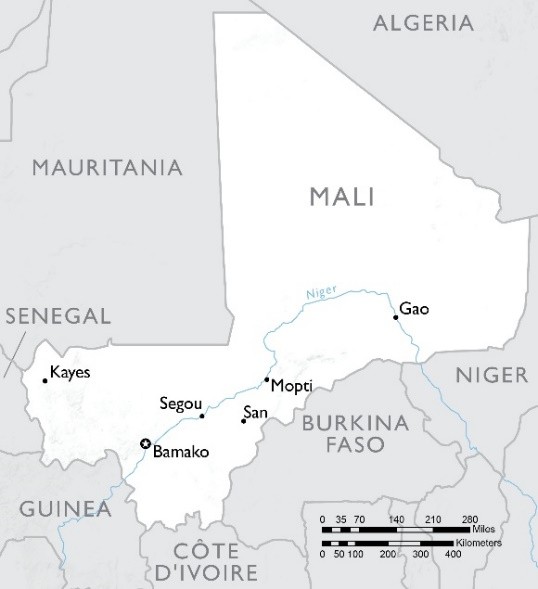Home » What We Do » Agriculture and Food Security » Food Assistance » Country Fact Sheets » Food Assistance Fact Sheet - Mali
- What We Do
- Agriculture and Food Security
- Democracy, Human Rights and Governance
- Economic Growth and Trade
- Education
- Ending Extreme Poverty
- Environment and Global Climate Change
- Gender Equality and Women's Empowerment
- Global Health
- Water and Sanitation
- Working in Crises and Conflict
- U.S. Global Development Lab
September 1, 2017
Food Security Situation

- Mali is considered one of the poorest countries in the world, ranked 175 out of 188 nations in the 2016 UN Development Program’s Human Development Index. According to the UN World Food Program (WFP), over half of the population lives on less than $1.25 per day. Recurrent natural disasters and limited livelihood opportunities also contribute to chronic hunger and malnutrition in vulnerable Malian populations.
- Since 2012, civil conflict has exacerbated food insecurity, particularly in the north, and spurred massive displacement. As of June 2017, there were approximately 52,000 internally displaced persons within Mali and 141,000 Malian refugees residing in neighboring countries.
- According to the USAID-funded Famine Early Warning Systems Network (FEWS NET), poor households in the rice-producing areas of Gao, Timbuktu, the Niger Delta and the western Sahel will face Stressed (IPC Phase 2) levels of food insecurity until September 2017. When the agricultural lean season ends in September, populations across Mali will face Minimal (IPC Phase 1) food insecurity until January 2018.1
Food Assistance Programs
- In response to the effects of conflict, the Office of Food for Peace (FFP) provides in-kind emergency food assistance through WFP for general food distributions, blanket and targeted supplementary feeding and food-for-assets activities. FFP also supports WFP’s local and regional purchase of food and distribution of food vouchers to bolster local production and markets. Through the UN Children’s Fund (UNICEF), FFP provides ready-to-use therapeutic food to treat children with severe acute malnutrition.
-
With the support of FFP, non-governmental organization partners provide cash transfers and food vouchers to food-insecure Malians in the north to both improve household access to food and spur market recovery. These partners are also helping to restore community infrastructure and diversify livelihoods.
- FFP partners with CARE to implement a five-year, $45 million development program to benefit more than 300,000 individuals in the Mopti region. The project aims to strengthen food, nutrition and income security among poor households and improve their resilience to future shocks. Activities focus on health and nutrition promotion, prevention and treatment of malnutrition, improved literacy, livelihood diversification and increased access to safe drinking water and sanitation.
Food for Peace Contributions
Total Contributions:
| U.S. Dollars | Metric Tons | |
|---|---|---|
| Fiscal Year 2017 | $27.5 million | 11,255 MT |
| Fiscal Year 2016 | $31.8 million | 6,968 MT |
| Fiscal Year 2015 | $48.3 million | 14,412 MT |
FY 2017 contribution based on funds obligated to date.
1: The Integrated Phase Classification (IPC) is a standardized tool that aims to classify the severity and magnitude of food insecurity. The IPC scale, which is comparable across countries, ranges from Minimal (IPC I) to Famine (IPC 5).
Country Specific Information
FY 2015 Mali Country Specific Information
2015 Mali BEST Analysis Annexes
USAID Office of Food for Peace Food Security Desk Review for Mali, FY 2015—FY 2019







Comment
Make a general inquiry or suggest an improvement.